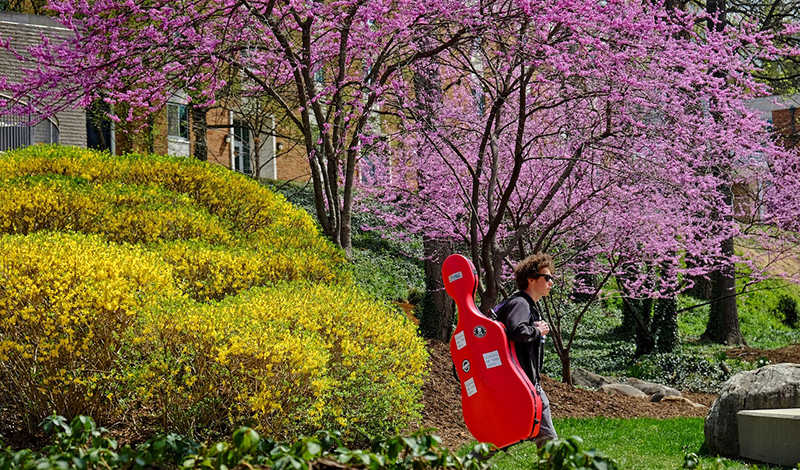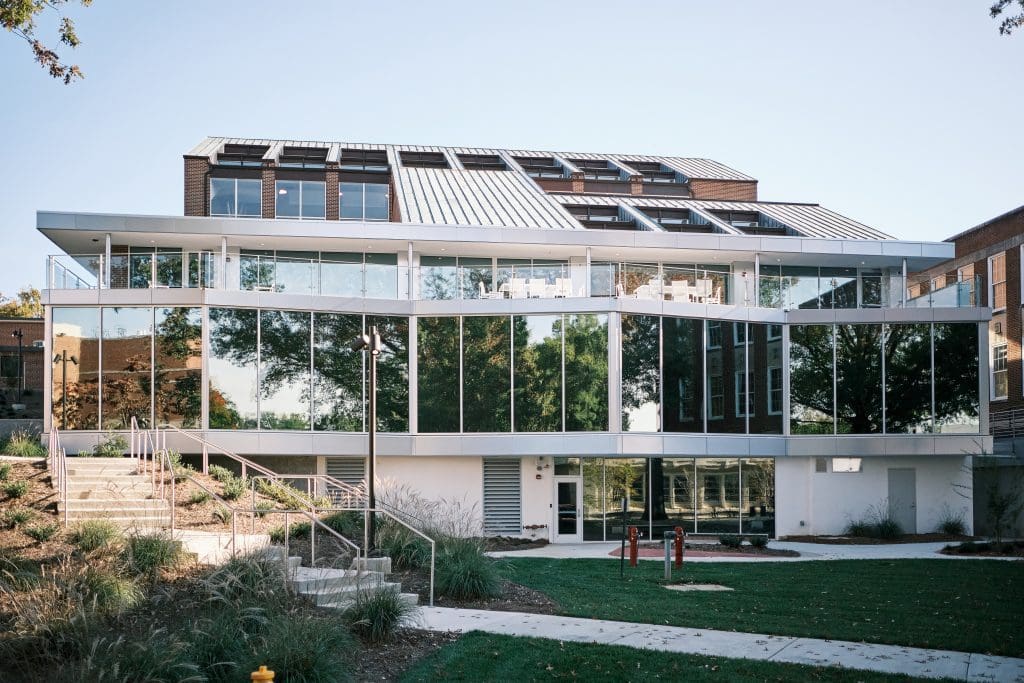University of North Carolina School of the Arts Administration
Five-yr Goals and Associated Interim Benchmarks
In January 2017, the Lath of Governors of the Academy of North Carolina unanimously approved Higher Expectations, a v-year Strategic Plan for the UNC Arrangement. The Plan calls on the UNC System to achieve ambitious goals in access, student success, affordability and efficiency, economic impact and customs engagement, and institutional excellence and diversity.
Progress on these goals and metrics will be achieved through the difficult work and commitment of institutional leaders, faculty, and staff. In that spirit, Academy of North Carolina School of the Arts has identified these contributions that University of Due north Carolina Schoolhouse of the Arts aspires to brand to the UNC Strategic Plan over the next five years.
From UNC School of the Arts: The University of North Carolina School of the Arts is Northward Carolina's only university devoted entirely to training talented students to go professional artists in the fields of dance, pattern and production, drama, filmmaking, and music. UNCSA reaches, trains and graduates students who have the nearly extraordinary artistic potential in our country. Artists shape our world by enriching our culture and feeding our souls. They also contribute billions to our local, state, national, and international economies. With the global arts and amusement industry changing rapidly and constantly, UNCSA is creating the future of the arts by grooming high school, undergraduate, and graduate students from all walks of life to be innovative and entrepreneurial. UNCSA has fabricated substantial progress toward our five-twelvemonth operation goals, guaranteeing that the university will proceed to atomic number 82 the arts in North Carolina and beyond.
Prioritize
Rural Enrollments
By autumn 2021, UNCSA will enroll 150 rural students, a 7% increase over 2016 levels (10 additional rural students over a base of operations of 140).*
Update: In autumn 2020, UNCSA exceeded its goal of 147 rural students with an actual count of 154 rural students. UNCSA is currently exceeding the autumn 2021 goal of 150 and is on track to surpass it.

From UNC School of the Arts: To ensure that every immature artist from Cherokee County to Cartel County considers the unique opportunities available at UNCSA, nosotros have instituted recruitment that targets rural communities.
During non-pandemic student recruitment seasons — when the Office of Admissions tin travel — virtually recruitment occurs in rural and/or N.C. Tier 1 and Tier two counties through the university'southward affiliation with the Carolinas Association of Collegiate Registrars and Admissions Officers (CACRAO). For case, 70% of travel in both 2018 and 2019 focused on higher fairs and/or school visits in these areas.
During the pandemic, with recruitment travel express or suspended, the Function of Admissions created dynamic online experiences that immune prospective students and families access to UNCSA admissions counselors. Auditions besides moved online, which again provided greater accessibility equally prospective students were no longer burdened with traveling to Winston-Salem or a major urban center to audition.
Additionally, the Office of Admissions supports application fee waivers for applicants in need.
* Numbers were re-estimated due to technical errors.
Click here to edit the advanced iframe block.
Rural Completions
By 2021-22, UNCSA volition produce 21 rural graduates, an increase of 31.3% (5 additional rural completions over a base of 16).
Update: For the 2019-xx academic year, UNCSA was on target with 19 rural graduates compared with a goal of nineteen and is on track to produce 21 rural graduates in 2021-22.
From UNCSA: After a pause for the pandemic, Educatee Advantage Week returned to an in-person session in August 2021. One plan goal has been to foster a sense of belonging and connexion for our students from Tier 1/Tier 2 rural areas of North Carolina. Workshops include conversations and activities focused on resiliency, stress direction, mindfulness, familiarity with campus support mechanisms, and the art of recovery.
Given the rigorous artistic grooming at the heart of the UNCSA student experience, the need for back up services during the pandemic has connected to grow. To address this need academically, the Sectionalization of Pupil Affairs actively gathers data from faculty through an Academic Early Warning Report, which is filed for concerns including excessive absences, lack of engagement, and low grades. Follow-up occurs at the arts school and Pupil Affairs levels to back up students in demand.
Additionally, Educatee Affairs provides financial support for students in the form of a general emergency fund, which helps those who experience circumstances that may jeopardize their health, safety, or operation. In improver, rural students facing food insecurity may avail themselves of free food and related items in the Pickle Pantry, which is entirely supported by donations from the greater UNCSA community.
Click here to edit the advanced iframe block.
V-year Graduation Rates
Past 2022, UNCSA will ameliorate its five-year graduation rate from any accredited institution to seventy.6%. This is an improvement over a base of 67.6% for UNCSA'due south 2010 cohort.
Update: In 2020, UNCSA improved its v-twelvemonth graduation charge per unit for the 2015 cohort to 76.iii%, well over the 69.3% goal for that flow. UNCSA is currently exceeding the 2022 goal of 70.half dozen% and is on track to surpass it.
From UNCSA: Recently, the Role of Admissions has focused on recruiting "best-fit" students. Our goal has been to amend brainwash prospective students and parents during the recruitment process on who we are equally a university, what type of students we are looking for, what our expectations are for enrolled students, and what it takes to succeed at UNCSA.
For some time, Admissions and Strategic Communications have collaborated to craft a communications programme that leads prospective students to the application, through the audition process and toward enrollment. Strategic Communications has focused on broader awareness and marketing of the artistic experience at UNCSA through a comprehensive branding campaign and has increased focus on video storytelling. These steps provide students with the cognition almost our programs to ensure they are the best fit for the conservatory experience. Changes take also been fabricated to the admissions feel online, via the Connect with UNCSA webpage. These efforts bring in stronger applicants at a stronger matriculation rate, which often leads to an improved graduation rate.
Starting in 2019, UNCSA partnered with Cappex, a leading college research and decision platform, which provides inquiries and prospective students based on criteria provided past UNCSA. This partnership has proven successful in delivering best-fit students. For example, 17% of submitted applications for fall 2021 came through Cappex leads. More importantly, 11% of the enrolled incoming course for fall 2021 was recruited through Cappex.
Click hither to edit the advanced iframe block.
Accomplishment Gaps in Undergraduate Degree Efficiency
By 2021-22, UNCSA volition reduce by fifty% the achievement gap in undergraduate degree efficiency between rural and non-rural students.
Update: For the 2019-20 academic year, UNCSA achieved a 15.vii actual functioning over a 15.i goal for the timeframe, and is on runway to increment rural students' undergraduate degree efficiency to xvi.half dozen in 2021-22.

From UNCSA:
In autumn 2019, UNCSA changed most of its programs to the 120-credit requirement for graduation to align with the amended UNC Policy on Fostering Undergraduate Student Success (UNC Policy 400.i.5). (Students already in attendance at UNCSA before fall 2019 could opt into the fall 2019 bulletin.) Many UNCSA caste programs required far more credits than 120 prior to 2019. This move shortened the time to caste past reducing the number of credits required and streamlined the procedure for greater efficiency.
Students can more easily manage their progress toward degree completion through the academy's implementation, in fall 2015, of the web-based caste tracking tool DegreeWorks. Using DegreeWorks has also led to an enhanced advising experience, as advisers take access to their students' degree progress via DegreeWorks equally well.
Click hither to edit the advanced iframe block.
Critical Workforces
By 2021-22, UNCSA will produce 14 disquisitional workforce credentials (xiv additional critical workforce credentials over a base of 0).
Update: Achievement of this goal has been postponed due to delays in the establishment of ii new programs targeting Disquisitional Workforces, and changes in the industry. For example, in Filmmaking, many of the new technologies are being integrated into existing programs such every bit cinematography and visual furnishings.
From UNCSA: The latest figures by the National Endowment for the Arts prove that the creative economy contributes $919.7 billion to the U.S. economy. UNCSA is training a highly skilled workforce for a multibillion-dollar global enterprise, which has unbounded potential for wealth and job creation in North Carolina.
Supported in function by a $10-million individual gift directed toward functioning innovation, UNCSA has launched a new three-year One thousand.F.A. concentration in its School of Design and Production in Animatronics. The program uses robotics to bring inanimate creatures/creations to life on stage, film, tv set, and in themed entertainment. It is the first of its kind in the nation. Afterward recruiting during 2020-21, the Animatronics Program launched in fall 2021 with three students.
Additionally, the School of Filmmaking's Media + Emerging Technology Lab (METL) launched its Immersive Storytelling Residency, which brings together a cross-functional team of technical artists, game developers, and screenwriters to develop immersive projects using emerging technologies under the mentorship of UNCSA faculty and manufacture leaders. "Black Ice," an interactive virtual reality curt created during the 2021 residency, has been accustomed to screen at the 2022 S by Southwest Movie Festival – the first UNCSA-fabricated picture show to do and so.
Click here to edit the advanced iframe block.
Improve
Low-income Enrollments
Past fall 2021, UNCSA will enroll 182 low-income students, a 7.seven% increase over 2015 levels (13 additional low-income students over a base of 169).
Update: In fall 2020, UNCSA surpassed the goal of 176 with an actual of 190 and is on track to surpass the low-income enrollment goal of 182 in fall 2021.
From UNCSA: UNCSA has demonstrated that increased recruitment focused on Tier i and Tier 2 counties results in increased rural enrollments (run into Rural Enrollments, to a higher place). Students in economically distressed counties are more likely to exist from low-income families.
Federal Pell Grants are awarded only to undergraduate students with exceptional financial demand. The number of students receiving Pell Grants at UNCSA in 2018-19 and in 2019-20 was higher than either 2020-21 or 2021-22, which were academic years affected by the pandemic.
The pandemic has acquired fiscal strain on many families, causing university affordability to be out-of-attain, and leaving low-income students hesitant to leave home to attend college. Four just-released national surveys of loftier school students in 2020 and 2021 found that only 48% were considering a four-year higher, down 72%.
Click here to edit the advanced iframe block.
Low-income Completions
Past 2021-22, UNCSA will produce 43 depression-income graduates, an increase of xxx.3% (10 boosted low-income completions over a base of 33).

Update: UNCSA produced 56 low-income graduates in 2019-20, well over the goal of 39 for the academic yr, and is on runway to surpass the goal of 43 in 2021-22.
From UNCSA: Known for its high-performing students and pinnacle-caliber performances, UNCSA offers a rigorous training program for student-artists who seek to become professional artists. Merely students from depression-income families ofttimes struggle with the difficulty of full-time school and office-time work.
UNCSA established the Keep Me UNCSA Emergency Scholarship Fund to provide emergency financial assistance to support the toll of academic progress toward caste completion for high schoolhouse, undergraduate or graduate students who experience unexpected need due to demonstrated adverse financial circumstances or extraordinary hardship.
In addition, UNCSA has as well established the Technology Fund, which supports technology needs for students in financial need.
Federal pandemic aid was also available and awarded to students from depression-income families. The total corporeality of College Instruction Emergency Relief Fund (HEERF) Iii Emergency Fiscal Aid Grants distributed to students equally of Dec. 31, 2021, was $536,450.00. The total of both HEERF I and HEERF II Emergency Financial Aid Grants distributed to students as of Sept. xxx, 2021, was $868,886.
And, as noted in Rural Completions above, Student Affairs provides back up for students in the grade of a general emergency fund and, for food-insecure students, the Pickle Pantry.
Click here to edit the avant-garde iframe cake.
Undergraduate Degree Efficiency
Past 2021-22, UNCSA volition meliorate its undergraduate caste efficiency to 20.0 over a base of xix.1.

Update: For the 2019-20 academic year, UNCSA improved its undergraduate caste efficiency to 23.9 over a goal of 19.six, and is on track to run into the goal of 20.0 in 2021-22.
From UNCSA: Due to the structure of the UNCSA curriculum, the four-year graduation charge per unit is highly correlated with undergraduate degree efficiency. Efforts to improve graduation rates are provided in V-Year Graduation Rates higher up.
Considering of the COVID-xix pandemic, UNCSA moved totally online in March 2020. UNCSA statistics signal that undergraduates in their fourth year persisted during leap 2020; withal, other undergraduates did non.
Click here to edit the advanced iframe block.
Sustain
Research Productivity
Past 2021-22, UNCSA will receive $151,018 in inquiry and development sponsored program awards and licensing income, an increase of 5% ($7,171 additional over a five year average base of $143,847).

Update: UNCSA received $sixty,180 in FY 2020, well under the target goal of $143,847. However, UNCSA received $262,000 in 2019, more than the 2018 goal of $143,800 and more than the 2022 goal of $151,000. Fluctuations are to exist expected in this area considering of the limited number of grants and size of grants bachelor each year.
From UNCSA:
Four grants totaling $66,000 went to the Schoolhouse of Filmmaking's Media + Emerging Engineering science Lab (METL); three of them (from Epic Games MegaGrants, the National Endowment for the Arts, and the Small Business concern and Technology Development Center) were for METL'southward Immersive Storytelling Residency (see Critical Workforces, above). The 4th grant went to conference registration and fees. The program supports the pipeline of workforce preparedness and contributes to the immersive sector.
In other awards:
- The Emily Hall Tremaine Foundation gave $33,000 to subsidize Creative Catalyst Fellowships at Creative Greensboro, Elsewhere, and Mixxer.
- The Duke Energy Foundation gave $five,000 to support the Happy Hill Arts Program, in the grade of a matching grant to the Kenan Charitable Trust grant for Happy Loma capacity-building, used for summer arts educational activity programming.
- Wake Forest Baptist Medical Center gave $thirteen,000 to support Artists Reaching Children in Hospitals (Curvation), an educational outreach activeness of UNCSA, at the hospital.
Click here to edit the avant-garde iframe block.
* UNCSA results for several metrics are bailiwick to substantial year-to-year variation reflecting the relatively minor size of the UNCSA student population (about 1,300). Modest headcount variations often result in relatively large percentage changes, contributing to fluctuations.
Source: https://www.northcarolina.edu/institutions-and-affiliates/university-of-north-carolina-school-of-the-arts-five-year-goals-and-associated-benchmarks/
0 Response to "University of North Carolina School of the Arts Administration"
Postar um comentário